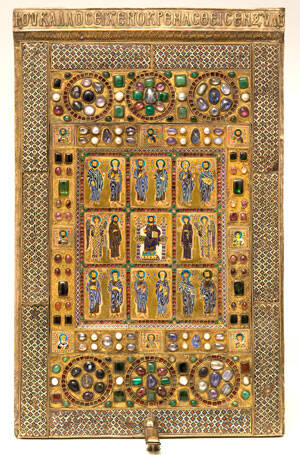Medieval pilgrims often slept in churches, finding respite there during their arduous journeys. But locals, too, had a wonderful familiarity with their churches, treating them as homes away from home. They bathed and did laundry with water drawn from holy wells and ate the food that merchants sold in the aisles. The smoke billowing from the enormous censer at the cathedral of Santiago de Compostela in Spain, for example, blessed not only the highly fragrant pilgrims crowded inside but also local Christians.
Medievals touched, kissed and asked for the prayers of the saints portrayed in stone, paint and stained glass, who were rendered with such verisimilitude that they seemed alive, like part of the family. Inside the church was a marvelous democracy of beauty that, like heaven, was available to poor and rich alike. By the 19th century, as the church tried to suppress some superstitious practices, the familial relationship of the faithful to their churches began to devolve into a more formal, less lively relationship with the structure itself.
In 1898, centuries after the heyday of the medieval pilgrim, Frederick Evans, a former bookseller, discovered his life’s calling: photography. In time, he built such a reputation as a photographer, particularly of the cathedrals he loved, that when he turned his camera’s eye to Westminster Abbey, custodians moved the pews and furnishings so he would have enough room to work.
Like the pilgrims before him, Evans would live in a cathedral for weeks at a time. He would walk the church, through the nave, down the aisles, around the cloisters and into its far corners from early morning until sunset, observing the subtle changes in light and atmosphere. One can imagine him, lugging his equipment, framing potential images in his mind and waiting until the light descended into the darkness in just the right way before clicking the shutter and capturing a holy world. Evans sought to create “a record of emotion rather than a piece of topography,” as he wrote in 1904. To do that, he had to become thoroughly familiar with the complex play of light and darkness that is the hallmark—beyond stained glass or flying buttresses—of the Gothic cathedral.
With a tenacity that would have drawn Evans’s admiration, the German photographer Achim Bednorz logged some 93,000 miles over the past five years to take the 1,000 photographs that grace Ars Sacra, an overwhelming, beautiful new book (h.f.ullmann, 2011). This massive encyclopedic survey covers Christian art and architecture in Europe from its beginnings in the catacombs of third-century Rome to the present day. Bednorz, who has photographed Christian architecture for nearly four decades, illuminates the inherent sanctity of the buildings and works of art he knows well and imbues their images with a sense of awe. His task, like that of Evans and every artist, was to understand how things look in order to re-present them in a way that transcends the material world.
Ars Sacra is organized chronologically, enabling readers to track cultural shifts and structural innovations. Overviews of soaring church interiors are coupled with illustrations of minuscule details that recall the story of the cathedral artisan who, when asked why he would carve a bird high in the rafters where no one could see it, replied, “God can see it.” This God’s-eye view is extended by the decision of the editor, Rolf Tolman, to emphasize the most significant developments of a given period, highlighting, for example, Romanesque sculpture, Gothic structural technology and Renaissance painting.
This is a book for the ultimate armchair traveler, although, since it weighs in at nearly 25 pounds, a table is needed, too. Hauling this tome from study to dining room and back renewed my appreciation of the literal and metaphoric heft of the visual arts, a precious legacy and wellspring of Catholic devotion.
Architecture, like photography, and like faith, is a creature of light. The world as most of us know it would cease to exist without light, which gives form to its visible dimensions. “Even a room which must be dark needs a crack of light to know how dark it is,” noted Louis Kahn, the modernist architect. Time is also shaped by light, its passage apparent in light’s evanescence—shifting, coming and going—a fleeting quality that moves us because it mirrors our brief time on earth. Light cannot be understood apart from darkness; knowledge of one depends on the other.
During the Advent season, as the days shorten, we fill our churches and homes with candles that focus attention on the light in the darkness, while acknowledging just how dark the dark can be. We reflect on the birth of light, the new light—Christ—remembering that Christ came into the world of visible realities to illuminate what cannot be seen. All the beloved symbols that accompany our celebration of Christ’s birth—the star, the crèche, the straw, sheep and camels—remind us that redemption is embodied and takes place in a world, now illuminated, that we can see.
View a slideshow of images from Ars Sacra.








